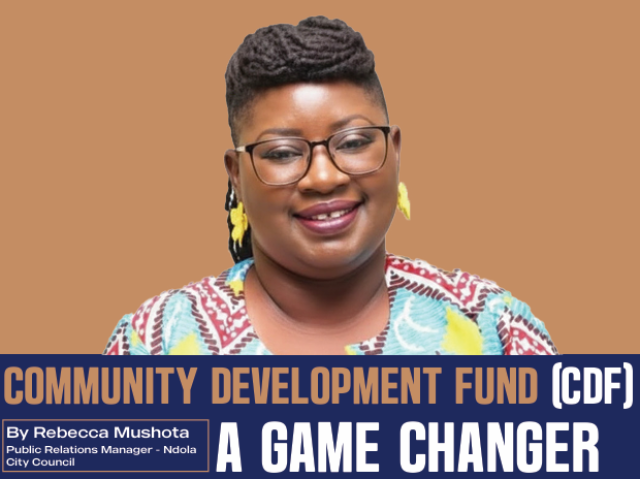Community Development Fund (Cdf) A Game Changer
- Posted on October 22, 2025
- By Excel Magazine Team
- 71 Views
Once a little-understood government initiative, the Constituency Development Fund (CDF) has evolved into one of Zambia’s most transformative programmes — and arguably President Hakainde Hichilema’s defining legacy. Originally introduced in 1995, the fund gained unprecedented momentum after 2021, rising from K1.6 million to over K36 million per constituency by 2025.
Across the country, CDF is reshaping communities — from new classrooms, clinics, and roads to youth training, business empowerment, and bursaries for vulnerable learners. In Ndola alone, more than K150 million has been channelled into community projects between 2022 and 2024, empowering over 8,500 young people with practical skills and supporting hundreds of small enterprises through low-interest loans and grants.
The results are visible: thousands of desks delivered to schools, better infrastructure, and improved access to essential services in constituencies like Chifubu, BwanaMkubwa, Kabushi, and Ndola Central. While some citizens still question its reach, the numbers tell a powerful story — that the CDF is indeed changing lives and redefining development from the ground up.

By Rebecca Mushota
Public Relations Manager - Ndola City Council
Many times, a topical subject and at times, a controversial one. The Constituency Development Fund (CDF) has drawn interest from people for different reasons.
Taking into consideration the various call-in radio programmes on multiple radio stations countrywide monitored, many callers believe in its existence with some testifying of its goodness while others lament that they are yet to experience its impact.
What is not doubted is that CDF is a topical issue that cannot be ignored.
For President Hakainde Hichilema, this is his flagship programme. A Game Changer. His Government has placed premium on this programme and this can be seen from the many pronouncements and the dramatic shift in operations of Local Authorities.
CDF has also accelerated Decentralisation. There are now some new prominent leaders in town and these are CDF Committee Chairpersons and the members as well as the Ward Development Committees (WDCs).
Even the pressure on Members of Parliament (MPs) has shifted somewhat as many are judged on how well CDF has ‘Delivered’ in their constituencies. Mayors and Councillors alike are also tasked by the public to deliberate on CDF and how best they could access it.
But do we know what CDF is?
Basically CDF is a Government programme that has existed since 1995 but was dramatically accelerated after President Hichilema assumed office in 2021. Hence the new popularity.
In 2021, CDF was K1.6 million per constituency and it was increased to over K25 million in 2022 and now stands at K36.1 million in 2025.
CDF is a Government funding programme that has different components. These components are Community projects, which accounts for 60 per cent of the funds. These include construction of public amenities such as classrooms, clinics, police stations, crossing points, market shelters, ablution blocks in markets and even the procurement of heavy equipment such as Graders and Tipper trucks.
The other component is the empowerment loans. These are loans of upto K200,000 each disbursed to companies and groups that are formally registered and are unable to get loans to invest in their entrepreneurship projects from banks at competitive rates and so they get these loans at five per cent interest.
The other component is the empowerment grants. These grants are given to groups of not less than 10 people upto K40,000 each and should not be paid back but should be invested in projects that can increase the fortunes of the group and enable them offer youths employment.
The other aspects are that of skills training bursaries offered to youths to pay for their tuition as they gain a skill that can help them be self-employed or get a job and the secondary boarding school bursaries granted to the vulnerable pupils.
The City of Ndola continues to benefit from the expanded CDF in all the four constituencies which are Ndola Central, Chifubu, BwanaMkubwa and Kabushi.
Collectively, the district has allocated over K150 million from 2022 to 2024 in community projects. These projects include health facilities, police posts and construction of classrooms.
Classroom blocks have been outstanding in all the four constituencies and generally the education sector has received significant funding through the construction of education facilities.
In addition, thousands of desks have been procured for each and every classroom newly built under CDF.
Ndola has contributed to the national desks procurement for pupils which has seen 1.2 million children in Zambia that initially sat on the floor now sit on desks.
The City has also recorded over 8,500 youths empowered with various skills such as catering, carpentry, public service vehicle driving, earth moving equipment operating and others.
Empowerment grants have also seen an increase in each year from 2022 to 2023 to 2024 with about K7.6 million being disbursed in 2022, over K8.6 million in 2023 and about K9 million in 2024.
For empowerment loans, about K36 million has been disbursed to beneficiaries who are well over 450 from all the four constituencies in 2022, 2023 and 2024. 2025 disbursement is still on-going.
CDF is indeed a game changer as it has enabled communities realise infrastructure, businesses and education goals that they previously only aspired of.
So going back to where we started from, with so much impact reported in this article, is it true then that some people are yet to feel the impact of CDF?
Let us take an example of the impact of some community projects in the City of Ndola.
The procurement of desks, maintenance of roads and drainages, provision of sustainable solid waste management and the procurement of tents in Chifubu Constituency served over 100,000 residents.
In Munkulungwe Ward in BwanaMkubwa, 16,700 residents benefited from the Water Reticulation (Katondo) Phase 1 project.
In Kansenshi Ward in Ndola Central, over 11,000 residents have benefited from the 1.4km of solar street lighting for Ndibu Road.
While in Kabushi Constituency, the purchase of 1,000 desks, contribution towards paving of Ndola Teaching Hospital roads, Improvement of Water reticulation System, Purchase of motor grader has benefited about 59,400 residents.
These are isolated projects.
With all these numbers just in isolated projects, it can be seen that a City with a population of 624,000 has impacted almost every resident.
What should happen now is that more has to be done to show the impact of CDF because it is there and numbers do not lie.



